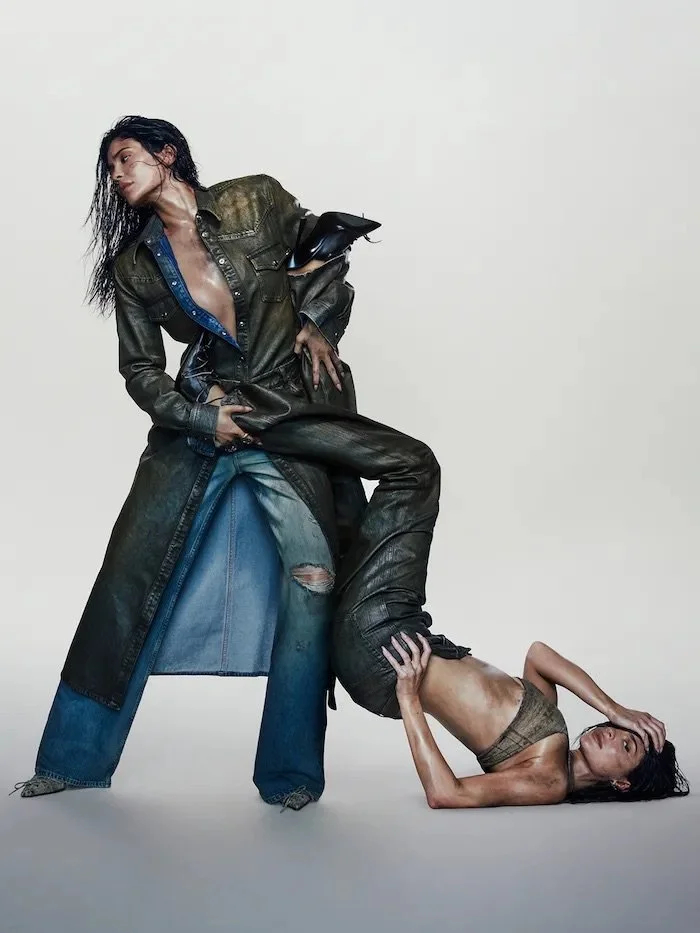Beyond Threads: Exploring the Deeper Layers of Denim
Denim, the fabric of rebellion and everyday wear, has journeyed through the decades, evolving from a symbol of rugged workwear to a staple of contemporary fashion. From the iconic Levi's 501s of the 1950s to the innovative designs of present-day brands like Diesel Marithé and François Girbaud, denim has remained a constant in the ever-changing landscape of fashion. Let's journey through time, exploring the evolution of denim from its humble beginnings to its current status as a wardrobe essential for millennials.
The Birth of Iconic Jeans
Photo: Vintage Levi jeans 1950’s Advertisement
In the 1950s, denim reached new heights of popularity by introducing iconic styles like the Levi's 501s, Wrangler jeans, and Lee Riders. Levi's, in particular, became synonymous with American cool, thanks to its classic designs and durable construction. The 501s, with their button fly and straight leg fit, became a symbol of rebellion for the era's youth culture. These jeans were not just a piece of clothing; they represented a lifestyle and attitude that resonated with a generation eager to break away from the conservative norms of the time.
Photo: James Dean, Dennis Hopper, Corey Allen, Nick Adams, Jack Grinnage, Beverly Long, and Frank Mazzola in Rebel Without a Cause (1955)
This rebellious spirit was immortalized in films like "Rebel Without a Cause," starring James Dean. Dean's portrayal of the troubled teenager Jim Stark captured the essence of youthful defiance and angst, and his wardrobe, including the now-iconic Levi's 501s, played a significant role in defining his character's persona. The film's impact on fashion was profound, solidifying denim as a staple for those seeking to express individuality and resist societal expectations. The sight of Dean in his jeans, paired with a white T-shirt and leather jacket, became an enduring image of calm, influencing fashion trends for decades.
Stonewashed and Beyond
Photo: Image via crfashionbook.com
Innovation knew no bounds in the dynamic landscape of denim fashion during the 1960s and 1970s. The emergence of stone washing techniques breathed new life into jeans, offering a worn-in, vintage aesthetic that captivated the masses. Brands like Levi's led the charge, introducing stonewashed variations of their iconic styles, setting the stage for denim's evolution into a symbol of effortless cool.
Lee Cooper's groundbreaking introduction of jeans for women with a front zip 1965 sparked a revolution in gender and fashion. This bold move challenged entrenched norms of femininity, sparking crucial conversations about inclusivity and diversity in denim. By defying traditional constraints, Lee Cooper empowered women to embrace denim as a symbol of empowerment and self-expression, paving the way for a more inclusive and diverse denim landscape.
The 1970s witnessed denim's ascent to fashion royalty as bell bottoms and flared jeans took center stage in counterculture fashion. Denim, more than just clothing, became a powerful statement of rebellion and self-expression, reflecting the era's spirit and intriguing the fashion world.
Photo: Lee Cooper Jeans 1971
The Rise of Designer Denim
Photo: Evisu Advertisment
The 1980s celebrated the climb of designer denim, with brands like Diesel, Marithé, and François Girbaud pushing the boundaries of traditional jeans design. Diesel, founded in 1978, introduced a new aesthetic with distressed and embellished styles, catering to a younger, more fashion-forward audience. Marithé and François Girbaud revolutionized denim with their innovative treatments and finishes, paving the way for experimental designs in the 1990s.
The 1990s and early 2000s witnessed a surge in the popularity of urban jeans, a trend heavily influenced by hip-hop's pervasive culture and streetwear aesthetics. Brands like Evisu and Akademiks epitomized this trend with their baggy jeans, oversized logos, and bold graphics, which became symbols of urban identity. Rappers, in particular, embraced this style, often wearing their jeans low-slung and oversized. Concurrently, premium denim brands such as 7 For All Mankind and True Religion emerged, offering luxury jeans with intricate detailing. Together with brands like Enyce, FUBU, and Karl Kani, they shaped the landscape of urban denim fashion, leaving an unforgettable mark on the intersection of hip-hop culture and streetwear.
Photo: Marithe & Francois Girbaud Advertisement
Contemporary Denim
Photo: Courtesy of Warp + Weft
Denim continues to evolve with the rise of sustainable and ethical fashion today. Brands like Reformation and Warp + Weft lead the way with their eco-friendly production methods and transparent supply chains. Meanwhile, contemporary brands like AG Jeans, Everlane, and Acne Studios offer modern interpretations of classic styles, combining traditional craftsmanship with innovative washes and finishes. Denim has become a symbol of versatility and individuality, transcending trends and reflecting today's millennials' diverse tastes and attitudes.
Photo: Acne Studios Taps Kylie Jenner for Fall Denim Campaign
Sustainability and Innovation
Photo: Nudie Jeans slogan
As we look to the future, sustainability and innovation will continue to shape the denim industry. Brands like Re/Done and Nudie Jeans are leading the way with their commitment to sustainable materials and production practices. Meanwhile, technological advancements in fabric development and manufacturing techniques are opening up new possibilities for denim design and construction. Denim will remain a timeless wardrobe staple, reflecting each new generation's ever-evolving tastes and attitudes.
Photo: Re/Done Spring 2024 Ad Campaign
Denim has come a long way since its humble beginnings in the 1950s. From the iconic styles of Levi's and Lee Cooper to the innovative designs of contemporary brands like Diesel, Marithé François, and Girbaud, denim has stayed a mark of identity and self-expression. As we move forward, the timeless appeal of denim will continue to inspire fashion lovers worldwide, bridging the gap between past, present, and future.











